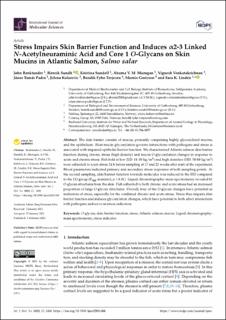| dc.contributor.author | Benktander, John | |
| dc.contributor.author | Sundh, Henrik | |
| dc.contributor.author | Sundell, Kristina | |
| dc.contributor.author | Murugan, Abarna V. M | |
| dc.contributor.author | Venkatakrishnan, Vignesh | |
| dc.contributor.author | Padra, Janos Tamas | |
| dc.contributor.author | Kolarevic, Jelena | |
| dc.contributor.author | Terjesen, Bendik Fyhn | |
| dc.contributor.author | Gorissen, Marnix | |
| dc.contributor.author | Lindén, Sara K. | |
| dc.date.accessioned | 2022-01-18T13:08:40Z | |
| dc.date.available | 2022-01-18T13:08:40Z | |
| dc.date.created | 2021-10-06T14:35:19Z | |
| dc.date.issued | 2021 | |
| dc.identifier.issn | 1422-0067 | |
| dc.identifier.uri | https://hdl.handle.net/11250/2837961 | |
| dc.description.abstract | The skin barrier consists of mucus, primarily comprising highly glycosylated mucins, and the epithelium. Host mucin glycosylation governs interactions with pathogens and stress is associated with impaired epithelial barrier function. We characterized Atlantic salmon skin barrier function during chronic stress (high density) and mucin O-glycosylation changes in response to acute and chronic stress. Fish held at low (LD: 14–30 kg/m3) and high densities (HD: 50-80 kg/m3) were subjected to acute stress 24 h before sampling at 17 and 21 weeks after start of the experiment. Blood parameters indicated primary and secondary stress responses at both sampling points. At the second sampling, skin barrier function towards molecules was reduced in the HD compared to the LD group (Papp mannitol; p < 0.01). Liquid chromatography–mass spectrometry revealed 81 O-glycan structures from the skin. Fish subjected to both chronic and acute stress had an increased proportion of large O-glycan structures. Overall, four of the O-glycan changes have potential as indicators of stress, especially for the combined chronic and acute stress. Stress thus impairs skin barrier function and induces glycosylation changes, which have potential to both affect interactions with pathogens and serve as stress indicators. View Full-Text | |
| dc.language.iso | eng | |
| dc.title | Stress Impairs Skin Barrier Function and Induces α2-3 Linked N-Acetylneuraminic Acid and Core 1 O-Glycans on Skin Mucins in Atlantic Salmon, Salmo salar | |
| dc.type | Peer reviewed | |
| dc.type | Journal article | |
| dc.description.version | publishedVersion | |
| dc.source.volume | 22 | |
| dc.source.journal | International Journal of Molecular Sciences | |
| dc.source.issue | 3 | |
| dc.identifier.doi | 10.3390/ijms22031488 | |
| dc.identifier.cristin | 1943838 | |
| dc.relation.project | Norges forskningsråd: 237856 | |
| cristin.ispublished | true | |
| cristin.fulltext | original | |
| cristin.qualitycode | 1 | |
